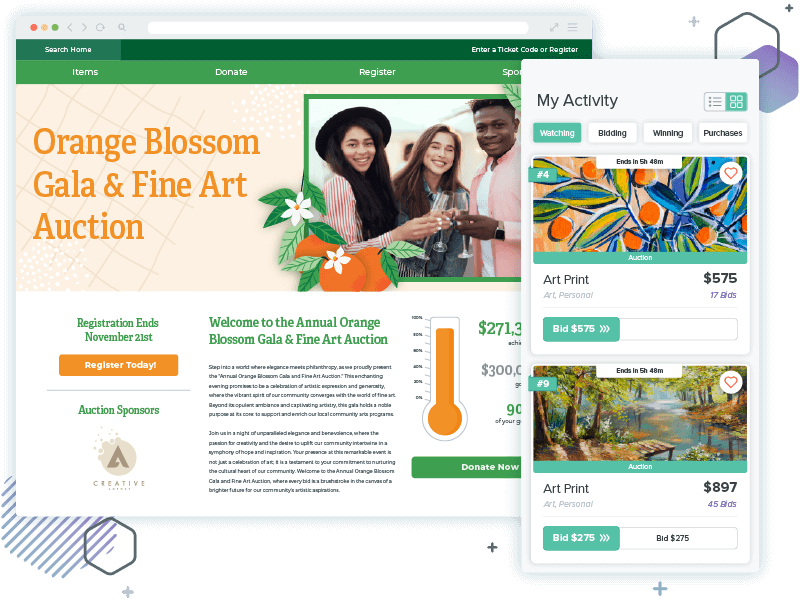Silent auctions are an art and a science. You need to wow your guests with great auction items and inspire bidding on those items. How can you make auction bidding more profitable for your nonprofit? We’ve broken down the science of better bidding. Here are four tips to earn more money from your silent auction items while easily managing incoming bids.

1. The price is right
Your starting or opening bid is the suggested minimum bid for an auction item. Most auctions don’t allow guests to bid beneath the starting bid for an item. Setting the right starting bid amount is the key to attracting bidders and making money on your auction items. But how do you know how to set the starting bid of an auction item? The key is conducting product research!
Determine the fair market value
Find similar items and compare prices across websites and in stores if possible. This helps determine what your item typically sells for. With auctions, bidders are looking for bargains. Set the starting price below fair market value to show your guests the potential for a great deal. Setting the starting bid around 40% of the fair market value or $5—whichever is greater—gives your bidders the chance to win the item well below market value. As the bids come in, your bidders will make an emotional connection with the items they’re interested in and will be more likely to bid higher than the original bar they’ve set.
Exceptions to the rule
Not all auction items are created equal. There are notable exceptions to the rule of 40% fair market value as a starting point for bids.
Auction items you bought
The first exception is purchased items. Obviously, you want auction items donated to your event at no cost, but sometimes that just isn’t possible. You may need to occasionally purchase auction items at a discounted price to fill out your auction offerings. If you’re auctioning off a purchased item, keep in mind what you paid. Set a starting price closer to what you purchased the item for to ensure you break even. Since this potentially limits your bidders’ interest if the price is too high, try to only purchase items you can get for well below the fair market value. To avoid losing money, set a reserve price close to what you paid and offer a ”Buy Now” price for a reasonable amount that’s close to fair market value and earns you a profit on the item.
Unique and high-value items
It’s hard to evaluate the worth of high-value or one-of-a-kind items, and whether they sell is often dependent on your guest list. However, vacation packages, event tickets, and one-of-a-kind memorabilia can sell for an incredibly high price.
Instead of researching the fair market value, determine what it cost the donor to provide this item and set their cost as a reserve price. Set a slightly higher starting bid, but don’t set it so high that your guests won’t want to bid if the price is driven up. Or keep starting bids low and set a higher bid increment to make more money while pricing these big-ticket items attractively. Another option for many auction guests would be to offer a ”Buy Now” price on unique and expensive items. Give your bidders the option to purchase high-value auction items outright at slightly under fair market value but above your cost for the items. This option guarantees you make a profit, and your bidders can easily acquire attractive auction packages.
2. Set sensible bid increments
With a starting bid in place, set a bid increment that drives bids. For an item with a known fair market value, aim to earn 70% of its retail price. Make bidding better for you and your guests by setting a bid increment that’s low enough to attract bids but high enough to get you to 70% of the item’s value in as few bids as possible. The general rule of thumb for silent auctions is to make the bid increment 10% of the fair market value or $5—whichever is greater. If you’ve set the starting bid at 30%, you can reach 70% in as few as four additional bids. Anything above those four bids earns you an above-average return on the item.
A blanket 10% bid increment sounds good on paper, but sometimes the fair market price means a 10% bid increment isn’t a whole number. Rounding in increments of 5, 10, 25, 50, or 100 keeps the numbers simple and helps you and your bidders figure out their next bid with quick math.
3. Reserve the right to set reserve prices
Just because your bidders bid on items you’re selling doesn’t mean you have to lose money on a particularly expensive item. If you or an item donor might lose money on an item that didn’t get enough bids to break even, set a reserve price to avoid selling an item far below its value. The reserve is the minimum bid your auction item must reach before you transfer ownership to a bidder. Reserve prices aren’t for every auction item. However, if your organization spent a significant amount on an item or if you were gifted a unique piece that collectors would want, a reserve price is the best way to protect the initial investment. Even if your item doesn’t fetch the price you expected, you can still get that price from the right buyer.
Monitor your results after the auction and pay attention to items where the reserve isn’t met. While your organization can still assign an item to the highest bidder if the reserve isn’t met, this helps determine if the item was overvalued or if it was just the wrong package for your crowd. This is valuable information you can bring to the table when planning for your next auction.
4. Use the right tools to manage auction bids
Paper bid sheets don’t work for every event. Some of your attendees may be too engaged with other areas of your event to monitor the items they want. Depending on your guests and your event’s structure, virtual or hybrid bidding might be better suited for your auction, but some bidders may not be comfortable bidding on their phones or computers. With Qgiv’s auction tools, you can host an auction that best suits your bidders, and you can easily manage your event with one software.
An auction management platform helps make managing bidding on auction items a better experience for your guests and saves your nonprofit a lot of time and effort when it comes to determining winners and managing payments.
Qgiv’s auction platform empowers nonprofits to manage their auction from start to finish and offers multiple bidding solutions for guests. Your attendees can bid one-handed, enable max bids they can set and forget, and check out using a credit card or eCheck—all from the Givi app or on the web. That increased automation saves your organization tons of time and makes you more money. With comprehensive auction software, you don’t have to worry about bidders leaving early. You can process your auction transactions in bulk to pay everyone’s balances when bidding ends!
Final thoughts
Get to know the ins and outs of the auction bidding experience. Gaining an understanding of an item’s fair market value makes setting a fair starting bid and bid increment much easier. Keep a 70% return on an item’s worth in mind so you can reach that target in as few as four bids. For high-value items, use your best judgment for a starting bid and bid increment. Set reserve prices to avoid losing money on big-ticket items.
The ultimate way to drive bids and make the bidding process more profitable is to use auction software to manage bidding. With Qgiv’s auction platform, your bidders can place bids from anywhere, which is especially helpful for hybrid events.
Additional resources
- Auction Success Toolkit. These helpful resources that will make hosting your next auction a breeze. Download the toolkit for planners, item ideas, inspiration and more!
- Virtual Auction Planner. We’ve put together a virtual auction planner to help you every step of the way with info on planning, acquiring auction items, setting and running your auction virtually.
- 25 Virtual Auction Item Ideas. These 25 themed item ideas for your next virtual auction are sure to inspire!




